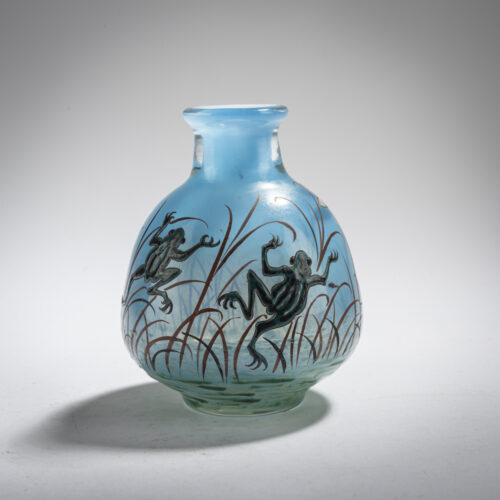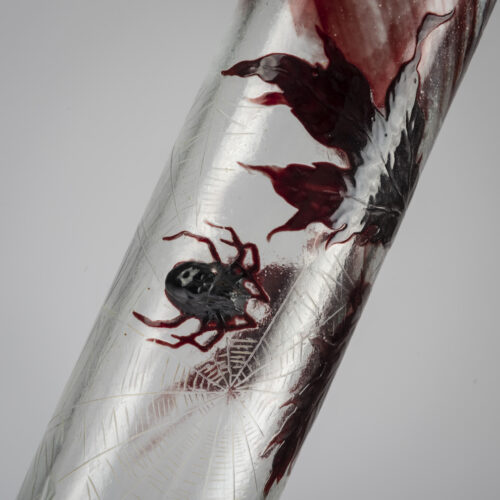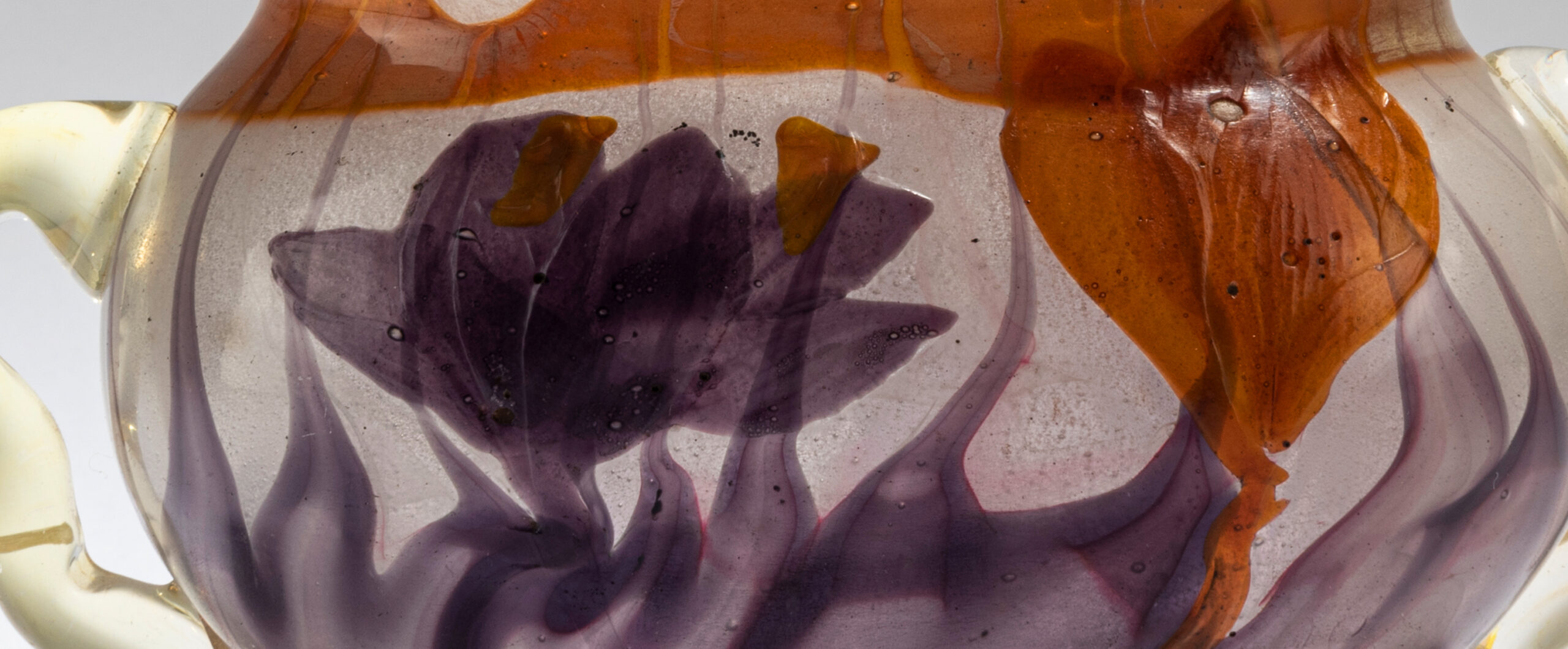
Emile Gallé – Alchemist of Art Nouveau
It is only rarely that one can admire such a wide range of Emile Gallé’s works in one auction. The 40 or so vases created during Gallé’s lifetime stem from three German and Austrian private collections. The stylistic and technical diversity of Gallé’s oeuvre is documented almost in its entirety and his world of motifs is depicted in a very impressive and exhaustive manner. Overlay techniques and marquetry, inclusions of foils, oxides and other materials, the so-called Patinage, as well as application of cabochons and threads, to name the hot techniques. Various cutting techniques, such as engraving or martelé and etching, enamel painting, to name the cold techniques. Historicist motifs, the mysterious world of symbolism, Japonism and Gallé’s love of the plant world determine the representation on Gallé’s works. All this features in the wonderful vessels that were created in the period around 1878 until shortly before Gallé’s death in 1904.
The earliest works in the auction were developed long before the heyday of Art Nouveau. Around 1878, he created the small ‚Chasse’ vase of colorless glass (€ 1.600 – 1.800). At that time, Gallé preferred working with clear glass. It references works from earlier periods that were back then made in rock crystal. The needle-etched hunting scene shows a hunter in fashionable 18th century clothing. The engraved volutes and palmettes as well as the enameled lip take up the Renaissance style. This kind of works were probably also shown at the Paris World Fair of 1878, when Emile Gallé presented himself for the first time exclusively with his own works of art and not with those of his father’s ceramic production. At this world exhibition, Gallé also presented the so-called ‘Clair de Lune’ glass, a pale, slightly opalescent bluish or greenish shimmering overlaid glass. In the auction, a small vase of this type with enameled snails is on offer for € 1.800 – 2.400 as well as a bluish vase with two frogs and a dragonfly in the same technique (€ 1.500 – 2.500).
The vase ‘Epis de blé et Insectes’, made in the second half of the 1880s, already anticipates the Art Nouveau era. The color palette is still restrained, the ground color shimmering in ‘Clair de Lune’ green, the decoration with its wheat ears and various insects is made in the naturalistic Japonistic style that was so important for the development of Art Nouveau. The elaborately etched and enameled vase with butterflies and beetles is estimated at € 2.000 – 2.500.
Around 1890, Emile Gallé created the ‘Sceau de Salomon’ jug. Its shape corresponds to that of a rolled leaf, the decoration is partly sculptural, with applied ribbons as flower stems and enameled blossoms, berries and leaves of Solomon’s seal. The jug, estimated at € 3.500 – 4.500, is an early purist work by the artist and characteristic of the Art Nouveau era. Gallé’s particular love of plants with narcotic or toxic effects becomes already visible here.
Two vases in the auction, both of which have a symbolist character, date from 1894. The nearly 50 cm high ‘Erable en automne avec toile d’araignée’ vase features a large sculpturally applied spider in its web amidst bright red leaves of autumnal vine (€ 5.000 – 6,000). Gallé created another vase, also decorated with vine leaves, in the form of a rhino tusk, here in a nocturnal mood (€ 5.000 – 6.000).
Gallé gladly made use of the symbolist-mystical range of motifs in particular works. He possessed a great general education, especially in the field of literature, was politically active and an expert in the world of botany. His choice of animals and plants as well as the depicted seasons, times of day and weather was never random. These contexts are quite visible in the use of spiders, bats or moths, or in the floral motifs of poisonous and medicinal plants, plants with intoxicating effects, nightshade plants or plants with erotic connotations. Thus, it comes as no surprise that these works are particularly popular with collectors.
At the end of the 1890s, Gallé created two vases in the same color palette, which are also part of the auction. In 1897/98, the flat marquetry vase ‚Colchiques’ with a handle was created in amber and violet glass (€ 3.500 – 4.500). The Marqueterie technique is an extremely elaborate technique and therefore very popular with collectors. Pre-shaped colored glass plates are rolled onto another glass body. Great technical skill and care must be exercised here, as the shape of the applied plates can barely be changed once they adhere to the other glass body. In successful pieces, the effect is much stronger than motifs worked out by cutting or etching. In the case of the small vase, a violet and an amber meadow saffron flower can be seen, standing in a hazy mood amidst streaky, distorted violet ribbons. The hazy autumnal mood is augmented with tiny included ‘impurities’, which appear as a bubbly cloudy intermediate layer and which Gallé called ‘patinage’. Meadow saffron is considered a symbol of transience because of its late flowering; the colchicine it contains has a healing effect at low doses but, at higher doses, is lethal.
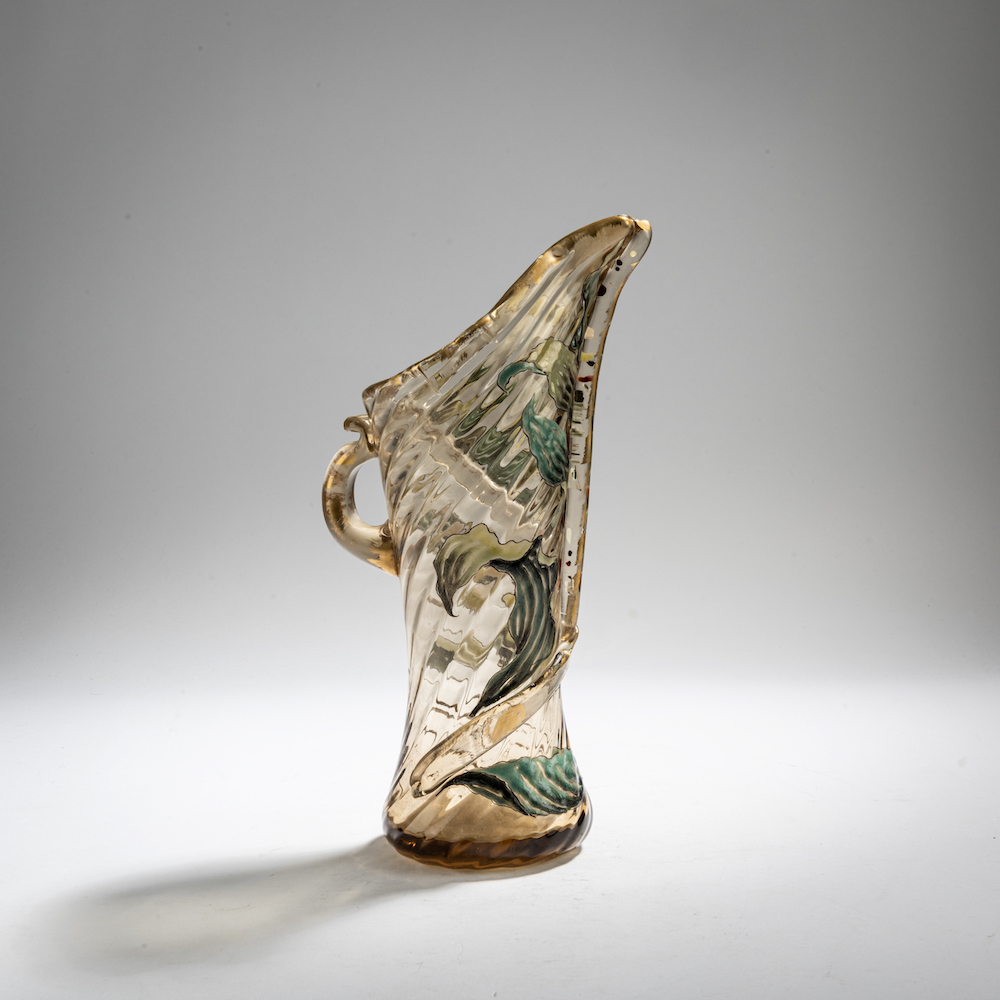
Jug ‘Sceau de Salomon’, c.1890
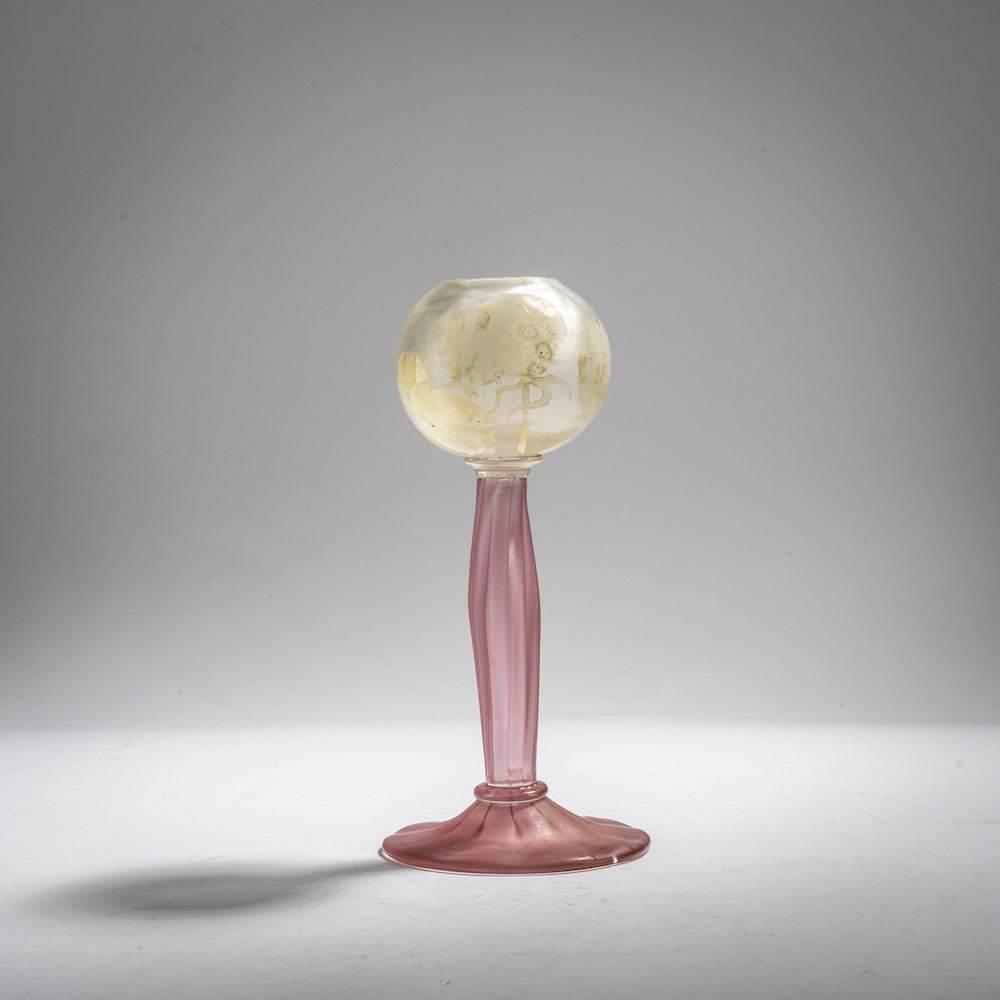
Vase ‘Pissenlit’, 1898
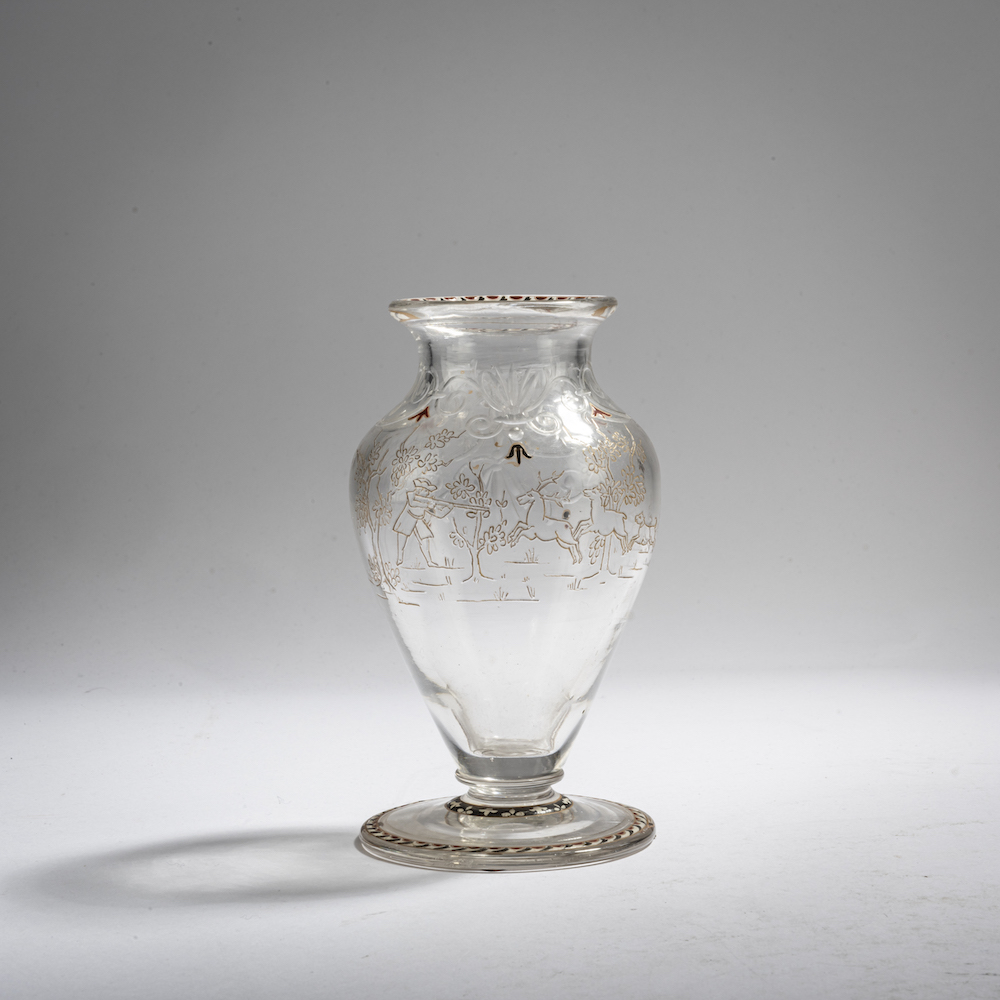
Small historicizing vase ‘Chasse’, um 1878
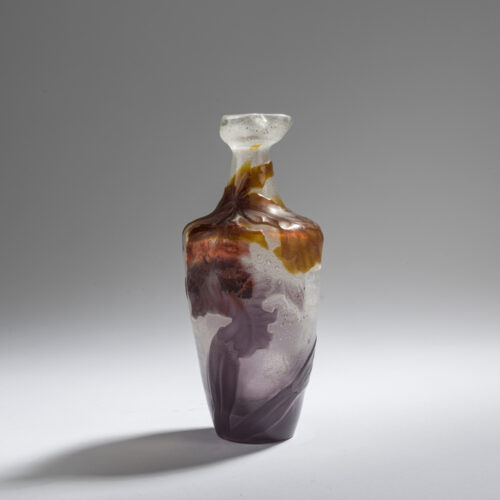
Vase ‘Cattleya’, c.1900
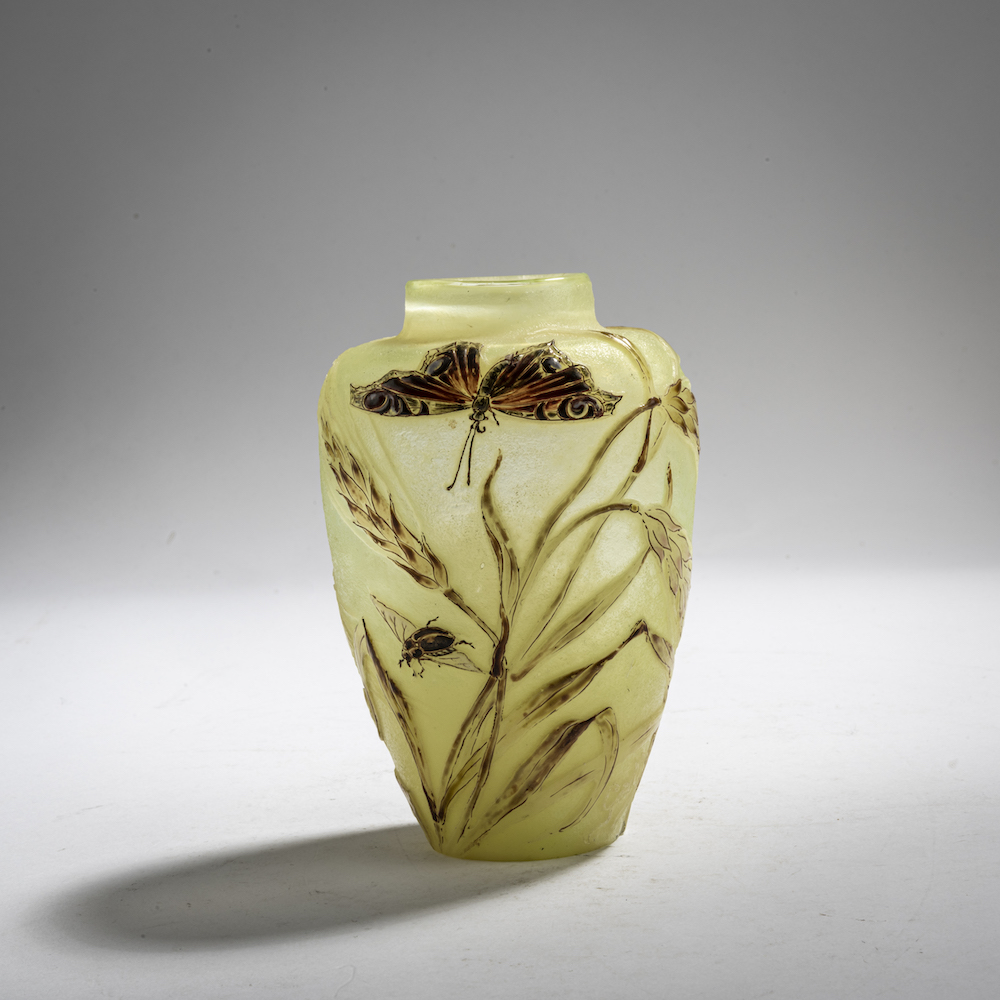
Small Vase ‘Epis de blé et Insectes’, 1884-89
A vase with the cut orchid motif of the cattleya displays the same color palette and was created by Gallé around 1900 (€ 6.000 – 7.000). Technically very versatile, the vase was equipped with foil inclusions and also features a beautiful ‘patinage’. The entire surface was elaborately cut. The clarity of the erotic connotation of the motif becomes clear when one considers that Marcel Proust used ‘Playing Cattley’ as an erotic code word between the protagonists in his serial story ‘In Search of Lost Time’ published a short time later.
In 1898, Emile Gallé developed another surface treatment technique, which he called ‘Patine’. Gallé made use of a surface matting caused by impurities in the glass furnace, which one would normally want to avoid in glass production. In a controlled process he created a matt shimmering, slightly structured and iridescent surface. In the case of the ‘Pissenlit’ goblet, this effect is only partially applied to the surface, probably with the help of stencils. Only the round, dandelion-like fruit stems are brought to life in this technique (€ 2.000 – 2.500).
Discover the diversity of these and the many other works of art from the Art Nouveau and Art Deco periods during the preview for the auction from 18 to 22 May and join us for the auction on 23 May on the floor, online or on the phone!
